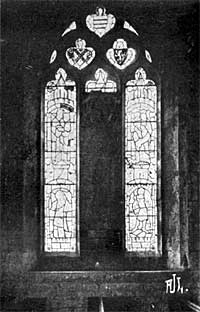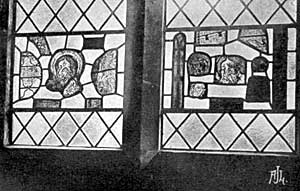THE ANCIENT GLASS.

East window, north aisle, Fledborough church.
The remains of stained glass in the windows arc of great interest. Many of the windows retain their canopies in situ, and the glass generally is of the early part of the 14th century, and coeval with the windows. The late rector collected fragments from various windows, the best of which have been skilfully worked up with new glass to replace lost pieces, and placed in the east window of the north aisle. This end of the aisle was screened off as a chapel. The window is remarkable as having its centre light filled up with masonry, and occupied by a canopied niche. The two lights on either side well reproduce the effect which all the windows must have had in their original beauty. All the old glass is of a beautiful greenish white colour; no colour is used except yellow or yellow stain. The shading is all smear shading— none stippled—and a delicate diaper is marked on the smear. The figures in the windows are, on the right hand, the Virgin and Child (the Holy Child's right arm, with a bird, is new; the left hand of the Virgin is wrongly inserted, and should probably be turned upside down and placed on the right). Below this is a knight in armour, holding up the cross hilt of his sword in his right, and holding a club in his left hand. The armour is mostly new glass. In the left hand light the upper figure is intended to represent St. John the Baptist, the hair garment being indicated. Below this is St. Andrew. The cross, I think, is new, but probably was suggested by the old fragments. It is of interest to note the inscription: "ET IN IHM XPM FILIU EJUS UNICU DNM NOSTRU "—And in Jesus Christ His only Son, our Lord." This no doubt refers to the legend that each Apostle contributed one of the twelve articles of the Creed, St. Andrew, the second on the list, bearing the second article. Probably therefore, the windows contained figures of the twelve Apostles with the twelve articles of the Creed as a consecutive series. Some details of architectural ornament are interesting, such as the straight canopied windows with an external shutter. The remains in another window of the south aisle are somewhat different in style, and have yellow stain in the arch and hair. The Virgin and Child in one of these is un-English, the Child holding out its arms with a curious expression. There are some fragments in a chancel window (north). The heraldic glass is described in a subsequent paper.
GENERAL REMARKS.

Fragments of old glass, Fledborough church.
The font is a plain octagonal one. There is a water stoup inside the church by the south door, and a much defaced oak poor box with the inscription, "Remember the poore 1684." The roof is of plain rafters with tie beams and purlins, very flat and modern. There are two bells: (1) "Sanctus Gregorius," 2ft. Sin. diameter, (2) "Prayse the Lorde, 1600," (H. Oldfield's shield) 2ft. 61/2in. diameter. The church is dedicated to St. Gregory. Of the registers No. 1 begins 1562, and is imperfectly kept till 1613, ending 1698. No. 2, 1700. The church obtained notoriety for runaway marriages during the time of the Reverend W. Sweetaple, rector and surrogate. His entries of marriages begin in 1721. There were seven in 1730, and from 1731 he adds: "By licence granted by me." There were eight marriages in 1731, sixteen in 1732, thirteen in 1733, and forty-four in 1753. He died August 31st, 1753, and was buried in the south aisle. On August 11th, 1820, Dr. Thomas Arnold, the famous head-master of Rugby, married Mary, youngest daughter of the Rev. John Penrose, rector of Fledborough. Dean Stanley, in his "Life of Arnold," mentions Fledborough, and Keble also mentions it in an occasional poem. The Rev. John Penrose was buried here, 17th September, 1829, by John Keble, Fellow of Oriel College, Oxford. One of Mr. Penrose's sons married Miss Cartwright, of East Markham, the authoress of "Mrs. Markham's History of England." She is buried in the cloisters of Lincoln Cathedral.
